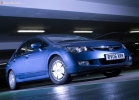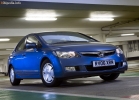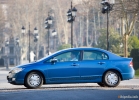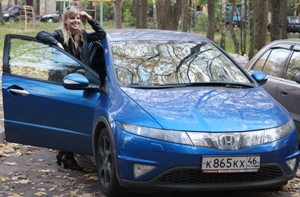Test drive Honda Civic sedan 2006 - 2008 sedan
The secret of the third pedal
 The cult and terribly scarce in Russia Honda Sivik against the novelties of this season Kia Sid and Toyota-Auris. Cars, and above all, the influence on their nature of robotic and automatic transmissions, was studied by Sergey Voskresensky. Photo: Alexander Kulnev.
The cult and terribly scarce in Russia Honda Sivik against the novelties of this season Kia Sid and Toyota-Auris. Cars, and above all, the influence on their nature of robotic and automatic transmissions, was studied by Sergey Voskresensky. Photo: Alexander Kulnev. Honda Civic
The current generation was presented in Frankfurt in 2005. The 5-door hatchback and sedan are released with bodies.
Engines: in Russia gasoline 1.8 liters (140 hp).
Gearboxes: 6-speed mechanical (or robotic), 5-speed automatic.
Complete: Sport, three execution options.
Price: 665 550768 736 rub. ($ 26,00030,000).
Kia Ceed
The five-door hatchback made his debut in September 2006 at the Paris Motor Show, in the summer of 2007 began
 sales in Russia.
sales in Russia. Engines: gasoline 1.42.0 l (109143 hp) and diesel 1.62.0 l (115140 hp).
Gearboxes: 5-, 6-speed mechanical, 4-speed automatic.
Complete: LX, EX.
Price: 452 800616 000 rub. ($ 17,70024,000).
Toyota auris
The hatchback (in the past version of the Corolla) received its own name and another body. Autumn 2006 debut.
Engines: in Russia gasoline 1.41.6 liters (97124 hp).
Gearboxes: 5-speed mechanical or robotic (1.6 l).
Configurations: eleganes, prestige.
Price: 517 000635 500 rub. ($ 20 20024 800).
The creators of these hatchbacks tried to make them extraordinary, expressive, to give them outstanding abilities. Techniques used different ones. Sometimes it seems that it is not only in contrasting technical and stylistic solutions, but also in the age approach. It seems that one car was designed by mature people, they chose between practicality and beauty, focusing on a wide consumer. Another creation of nothing afraid of the originals, designed primarily for the young ...
The intrigue of the dough is that in addition to diverse consumer qualities, engines of different volumes (1.8 liters of Honda and 1.6 liters of Toyota and Kia) and robotic mechanical boxes that suddenly received a head start from a regular machine gun argue. So, cars without a third pedal.
 Guest from the future
Guest from the future Probably, a colleague is right: the current Sivik is the cosmos ... the cunning of the lines, the changes in the designer mood, rushing between functionality and a burning desire to surprise. So in fantastic films they show the car of the age of the future. Despite the certain length of sales, the car still attracts attention on the streets. Many are not aware that Honda has already gone for uncomfortable, moreover, cheaply creaking external door handles. For a very littered front stand in the style, bow, bow! And a fit of claustrophobia caused by the size of the side and rear windows.
Much, it seems, is designed for 20-, well, maybe 30-year-olds. Although for the rest in Honda there is nothing unnatural. Excellent anatomical seats, a nice grip steering wheel, perforated pedals. Mild aggression blows from every detail of the cabin. Nevertheless, only young people are able to put up with the unevazhnetsk visibility, a bright but uncomfortable combination of devices, inaccessible to the conspicuous tooths ...
Start! Hitch? A pause, and finally the original voice of the motor, waking up after endlessly smooth transmission compounds. He seems to sing: Honda, Honda, Honda ... Then the long nod of the head by inertia accompanies a truly endless pause to switch and 13-second acceleration to a hundred. No, this is no longer Honda!
She tries to prove the advantage with all her might: she rushes forward at the slightest touch to the accelerator (which, incidentally, interferes with traffic jams very much), frantically sorting through the transmission of 6-speed robotic mechanics, sensitively tracking the movements of the steering wheel petals. But it is worth it, believing in 140 horses, to spur them on overtaking without forced choice of the necessary transfer of the theater pause again. Then an explosion of emotions, both the driver and the car, ending with mutual claims. Yes, the transmission is clearly a weak link.
Probably, reproaches would have gained much less, if everything else was charged according to the sports program. And here, a very sensitive, directly nervous steering car does not even react to the movement of the steering wheel, but to a barely noticeable impetus, which immediately captivates the sivik in a turn. You are waiting for the departments of tires, body rolls, delay. But Honda seems to be ideally designed for a ring riding. Of course, like any finely tuned tool, it does not tolerate a panrabic, especially in choosing the speed at the entrance to the turn, but this emphasizes its fighting deposits. Alas, the suspensions of such a subtle organism are not at all designed for anything but even asphalt. On it, Sivik is even more comfortable than you expect, perfectly copes with gentle waves. But it is worthwhile to appear more serious irregularities of the suspension instantly and noisily surrender, without providing the pardon with any resistance. In general, Honda Sivik is interesting, but very contradictory.
 Servant of different gentlemen
Servant of different gentlemen In terms of individuality, Kia Sid is far from ideal, it is difficult to compete with Honda. But behind a pretty international appearance hides a car that is definitely focused on Europe. He is alien to shouting, he unobtrusively offers to evaluate considerable door openings, a spacious and light salon, and an expensive finish. On the ingenuous, but quite comfortable seats you sit comfortably, reliably cling to the steering wheel, by the way, adjustable in two directions. The most common, at the same time spacious and friendly combination of devices, understandable settings of the climatic installation. That's it, you can go! In contrast to the avant-garde Sivik to Kia, you do not need to get used to, adapt, convince yourself that high-tech is fashionable and even necessary.
The Commonwealth of a 122-horsepower engine with a conventional hydromechanical automaton causes a lyrical mood rather. Soft start from a place, smooth acceleration, almost inconspicuous gear shift. After the impulsive, but rather stupid work of the Honda transmission, the process of acceleration of SID seems how perfect, so boring. Of course, you can make the motor roar the strain and very far from the juicy Revy Sivik with a voice. Gas to the floor and after a brief pause, Sid obediently rushes forward, honestly practicing its 13.8 seconds to hundreds. He will give a little to the competitor in ceremonial numbers, but the predicted behavior will cause much less reproaches and discontent.
Do not rush to write down in the category of female cars for a smooth automatic machine, calm acceleration is hardly for the weaker sex unexpectedly hard, muscular pendants. They repeat the profile of the road in detail and at the same time reliably soften the shocks on pits and potholes. Yes, and a sharp, very sensitive steering force makes each movement with a steering wheel, poured with an excellent feedback. Is it worth it to be surprised that at high speed the SID is harsh, impulsive and requires remarkable concentration from the driver. Another athlete?
Aggressiveness, assertive reactions at the entrance to the turn, certainly succeeded. But still, the Korean is not so accurate in management, he has more chips of the body, and out of turn, he seeks to fall out more actively. In a word, you expect a little more from the car than it gives.
 The principles of self -sufficiency
The principles of self -sufficiency In a few days, it is difficult to reveal all the secrets of Toyota. But regardless of whether the appearance, the materials of the interior decoration, or not the sledged possibilities like, soon you already perceive Auris as an old acquaintance. It does not have a pronounced age categorical, it is in itself. You can criticize a beautiful, but completely uncomfortable handbrake, a hump under the shoulder blades, which prevents you to comfortably sit at the wheel, to complain on the slobberly gear robotized gear shift ...
But be sure: very little time will pass and your body will take the usual position, arms and legs will feel the logic of managerial decisions, and your eyes will learn to ignore the excess. Then it turns out that the Toyota robot is different than that of a fellow countryman. Here is a more clear switching algorithm, and the presence of a sports regime (ES Tumbker) facilitates the understanding of the transmission. The gas pedal with a large move helps to rationally control overclocking, saving on switching. And in the end, five steps are more logical and easier than six!
However, the pauses between the programs at first interfere, each time forcing to calculate the leisurely rhythm when overtaking. But ... the actions of a driver who does not seek to drown the accelerator pedal on the floor are increasingly correct. The electronics will calculate the situation in advance a little more smoothly and will allow you to make the plan much faster. The engine will pick up and juicy on a high note, demonstrating not at all ordinary. Auris, who seemed to be a realization of calmness, suddenly rushes forward, easily rivaling with Honda, and leaves behind the Korean, diligently twisting the motor in each gear.
Yes, at the same time, he will not create a sense of the elbow characteristic of Sivik, will not give it incendiary handling. But it will turn out to be much better in the settings of pendants. It will not surprise the extreme sharpness of the reactions to the turns of the steering wheel, like SID, but at the same time in fast turns it will behave easier and more understandable, and most importantly predictably. Perhaps, it is in the balanced approach to any tasks that the main secret of Toyota-Auris was concluded.
Mind or heart?
Or maybe the Honda sellers are right, which is clearly in no hurry to fill Russia with siviks. Indeed, in relation to the car, a line per year with a tail is a decent period to verify intentions. Perhaps such cars are more likely to be designed for gourmets. They, I think, will have no doubt, buy a hatchback with a robot or pen, the choice of true Honda fans is obvious.
Kia-SID is a serious application for success: a high level of equipment, an interesting set of sledges. Potential owners should clearly represent the expectations of the car. Those who crave emotions are contraindicated.
If you recall the Toyota automatic boxes of the past generation and try them on Auris, everything will fall into place, and the car will conquer with dynamics. At least for those who are ready for a compromise for the abandonment of the third pedal, the transition to the robot will not be painful.
Cars were provided by representatives of Honda Motor Rus, Toyota Motor and Inkom-Auto.
 Sergey Voskresensky: When I see a car hesitated during rebuilding, and then rushing into a neighboring row, I justify his driver: not otherwise, a robot, implying, of course, a transmission. However, the question suggests itself: why should we adapt to them, and not they to us?
Sergey Voskresensky: When I see a car hesitated during rebuilding, and then rushing into a neighboring row, I justify his driver: not otherwise, a robot, implying, of course, a transmission. However, the question suggests itself: why should we adapt to them, and not they to us? Honda Civic is expressive, but we wish you more practicality, at least in terms of adaptability to our roads.
General assessment 7.6
+ Spacious interior, roomy trunk, comfortable seat, magnificent handling and brakes.
- inexpressive dynamics, low energy intensity of pendants, mediocre visibility.
KIA CEED is an unusual combination of European respectability and rather hooligan settings of pendants and steering.
General assessment 7.9
+ A spacious, spacious interior, high quality of finishing materials, large road clearance, impulsive chassis.
- A modest dynamics in this version, hard pendants, too sensitive brake pedal.
Toyota auris restrained and very thoughtful solutions. Although not without flaws, the car knows how to convince of its considerable advantages.
General assessment 8.1
+ High levels of equipment, temperamental engine, good acoustic comfort, balanced behavior on the road.
- A small trunk, an uncomfortable configuration of the back of the driver's seat.




















Source: The magazine "Driving"
Honda Civic Crash Test Video Sedan 2006 - 2008
Honda Civic Sedan 2006 test drives - 2008
Honda Civic Crash Test Sedan 2006 - 2008
Krassh Test: Detailed Information31%
Driver and passengers
21%
Pedestrians
38%
Children-passengers












